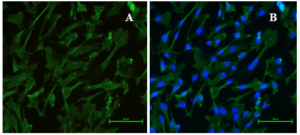Unveiling the Neurogenic Marvel: WJ-MSCs’ Trans-Differentiation Journey into Neuronal Stem Cells via Neuronal Conditioned Medium
Dr. Lija. S, Dr. Eswari. S
*lijas2k9@gmail.com 1PhD Research Scholar, Division of Animal Physiology, ICAR-NDRI, Karnal, Haryana, India-132001
2 Professor and Head, Centre for Stem Cell Research and Regenerative Medicine, Madras Veterinary College, Chennai, Tamil Nadu, India-600001
Introduction
Stem cells are undeveloped cells capable of proliferation, self-renewal, conversion to differentiated cells, and regenerating tissues. The functional properties of stem and progenitor cells appear to be defined by their natural environment, called the ‘niche’. Pluripotent stem cells are the descendants of totipotent cells and can differentiate into nearly all cells, i.e., cells derived from any of the three germ layers. Multipotent stem cells can differentiate into several cell types, but only those of a closely related family of cells. Oligopotent stem cells can differentiate into only a few cell types, such as lymphoid or myeloid stem cells. Unipotent cells can produce only one cell type, their own, but have the property of self-renewal, which distinguishes them from non-stem cells.
In the pursuit of advancing regenerative medicine, the study of mesenchymal stem cells (MSCs) has garnered significant attention for their remarkable potential in tissue repair and regeneration. Among these, Wharton’s Jelly-derived MSCs (WJ-MSCs) stand out for their unique characteristics and accessibility. In this ground-breaking research, we delve into the transformative capabilities of WJ-MSCs as they undergo trans-differentiation into neuronal stem cells, a process facilitated by the application of neuronal conditioned medium. This innovative approach not only taps into the regenerative potential of WJ-MSCs but also explores the intriguing realm of trans-differentiation, shedding light on the intricate cellular mechanisms involved. As we navigate through this scientific exploration, our findings promise to contribute valuable insights to the evolving landscape of stem cell research, offering new perspectives and possibilities for the development of therapeutic interventions in neurological disorders and beyond.
Wharton Jelly MSCs
Wharton’s jelly of the umbilical cord (UCT-WJ MSCs) are a rich source of primitive cells, can be expanded, and maintained in culture and have the potency to trans-differentiate into a neural phenotype in vitro, using Neuronal Conditioned Medium (NCM). The stem cell secretome includes cytokines, chemokines and growth factors, and has gained increasing attention in recent years because of its multiple implications for the repair, restoration or regeneration of injured tissues is widely expressed in WJ MSCs apart from bone marrow MSCs. The WJ MSCs itself possessed the trans-differentiation potential as well as the secretome, BDNF in the conditioned media represents, it as a promising candidate for a novel cell-based therapy in treating neurodegenerative disorders. Thus, we hypothesized that the WJ MSCs induced NSCs are a potential source of stem cells that may serve many therapeutic and biotechnological roles in neuroregenerative medicine.
Methodology
Key Findings and Results



Figure 1. Collection of ovine foetal brain tissue, washing of brain tissue in PBS with antibiotic-antimycotic solution and transferring the brain tissue suspension in culture medium for in vitro culture for collection of Neuronal conditioned medium.


Figure 2. 1 Processing of Ovine UCT. 2. Separation of WJ. 3. Migration of MSCs from digested WJ tissue.(200x) 4. Induced Neural SCs using NCM (200x)



Figure 3. Expression of CD markers –RT-PCR B,C. Immunofluorescence for the marker CD 90 -DAPI ,FITC, Immunofluorescence for the marker CD 73 by DAPI, Texas red



Figure 4. Expression of Nestin, β III Tubulin and GFAP by RT-PCR A,B. Immunofluorescence for the NESTIN marker -DAPI, FITC
QUANTIFICATION OF SECRETOME – Brain Derived Neurotropic Factor
The quantification of the secretome, specifically focusing on Brain-Derived Neurotrophic Factor (BDNF), stands at the forefront of contemporary research in the field of neurobiology and regenerative medicine. BDNF, a crucial member of the neurotrophin family, plays a pivotal role in neuronal survival, differentiation, and synaptic plasticity. Ascertaining the precise levels of BDNF within the secretome provides valuable insights into the intricate signaling mechanisms governing neural function and repair.
- The quantification of secretome BDNF in the NCM from ovine foetal NPCs, WJ MSCs induced NSCs-CM and WJ MSCs-CM was done using ELISA
- Showed the BDNF levels at 873.90 ± 12.16 pg/ml, 625.57 ± 6.00 pg/ml and 481.12 ± 23.08 pg/ml respectively.
- A highly significant (P < 0.01) difference was observed in BDNF level among the three different conditioned medium.

Figure 5. Quantification of BDNF (pg/ml) in conditioned medium (n=6) samples
CONCLUSION
- The data supports the WJMSCs are readily differentiated into NSCs when cultured in NCM alone without adding external growth factors/cytokines in vitro, exhibiting both morphological and molecular properties of neural cells and expressing typical neuronal proteins such as Nestin
- The secretome BDNF in the conditioned medium of the WJ MSCs induced NSCs represents that these neuronal induced cells are a potential source of stem cells that may serve many therapeutic and biotechnological roles in neuroregenerative medicine
- Wharton’s jelly of the umbilical cord (UCT-WJ MSCs) are a rich source of primitive cells, can be expanded, and maintained in culture and have the potency to trans-differentiate into a neural phenotype in vitro, using Neuronal Conditioned Medium (NCM)
- WJ MSCs induced NSCs are the potent alternative source of stem cells for NSC transplant researches
- Further in vivo pre-clinical studies in animal model have to be done for evaluating neuroregenerative potential of induced NSCs
REFERENCES
- Lija S, Eswari S, Vijayarani K, Kumaran K. Potential of ovine wharton jelly derived mesenchymal stem cells to transdifferentiate into neuronal phenotype for application in neuroregenerative therapy. 2020. International Journal of Neuroscience, 130:11, 1101-1108
- Bierlein M., A.D. Sharma, S.K. Mallapragada and D.S. Sakaguchi, 2017. Transdifferentiation of brain-derived neurotrophic factor (BDNF)-secreting mesenchymal stem cells significantly enhance BDNF secretion and schwann cell marker proteins. Biosci. Bio. eng., 124(5): 572-582.
- Frausin, S., S. Viventi, L. V. Falzacappa, M. J. Quattromani, G. Leanza, A. Tommmasini and E. Valencic. Wharton’s jelly derived mesenchymal stromal cells: Biological properties, induction of neuronal phenotype and current applications in neurodegeneration research. Acta Histochemica, 1- 10. (2015)

